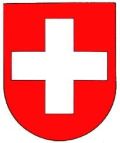Cham (Zug): Difference between revisions
Knorrepoes (talk | contribs) m (Text replacement - "[[Category:Swiss Municipalities" to "50 px|Link=Switzerland[[Category:Swiss Municipalities") |
Knorrepoes (talk | contribs) m (Text replacement - "'''Literature''':" to "'''Literature''' :") |
||
| (10 intermediate revisions by the same user not shown) | |||
| Line 1: | Line 1: | ||
'''CHAM''' | '''CHAM''' | ||
| Line 6: | Line 4: | ||
Canton : [[Zug]] | Canton : [[Zug]] | ||
[[File:chamz.jpg|center|Wappen von {{PAGENAME}}]] | [[File:chamz.jpg|center|alt=Wappen von {{PAGENAME}}/Arms (crest) of {{PAGENAME}}]] | ||
===Official blazon=== | ===Official blazon=== | ||
===Origin/meaning=== | ===Origin/meaning=== | ||
The origin of the bear in the arms of Cham is not clear. The most logical option is that the bear is taken from the arms of the Lords of Sellenbüren, who had quite some possessions in the area in the 12th and 13th century. <br> | |||
Another explanation is a local legend, in which a person from (now) the Netherlands passed through the area and was attacked by a bear. He survived the attack and ever since the bear is the symbol of the village. | |||
A third explanation tells that the arms are based on the arms of a governor/sheriff of King Charles the Great, as in the area there was a Royal farm/estate. However, the use of arms only started 300 years after the death of Charles the Great. | |||
In any case, the oldest use of a bear dates from a seal from 1384 on a land deed charter. | |||
{|align="center" | {|align="center" | ||
| Line 18: | Line 21: | ||
|} | |} | ||
{{ch}} | |||
{{media}} | {{media}} | ||
[[Literature]] : Iten and Zumbach, 1974 | [[Civic Heraldry Literature - Switzerland|'''Literature''']] : Iten and Zumbach, 1974; Faessler, 2017 | ||
[[Category:Swiss Municipalities C]] | |||
[[Category:Zug]] | [[Category:Zug]] | ||
Revision as of 13:28, 4 August 2023
CHAM
Canton : Zug
Official blazon
Origin/meaning
The origin of the bear in the arms of Cham is not clear. The most logical option is that the bear is taken from the arms of the Lords of Sellenbüren, who had quite some possessions in the area in the 12th and 13th century.
Another explanation is a local legend, in which a person from (now) the Netherlands passed through the area and was attacked by a bear. He survived the attack and ever since the bear is the symbol of the village.
A third explanation tells that the arms are based on the arms of a governor/sheriff of King Charles the Great, as in the area there was a Royal farm/estate. However, the use of arms only started 300 years after the death of Charles the Great.
In any case, the oldest use of a bear dates from a seal from 1384 on a land deed charter.
| Variations of the arms in the Kaffee Hag albums 1914-1960 |
|
Swiss heraldry portal
This page is part of the Swiss heraldry portal |
Heraldry of the World |
|
Swiss civic heraldry:
|
Other heraldry: |
Contact and Support
Partners:
Your logo here ?
Contact us
© since 1995, Heraldry of the World, Ralf Hartemink 
Index of the site
Literature : Iten and Zumbach, 1974; Faessler, 2017














